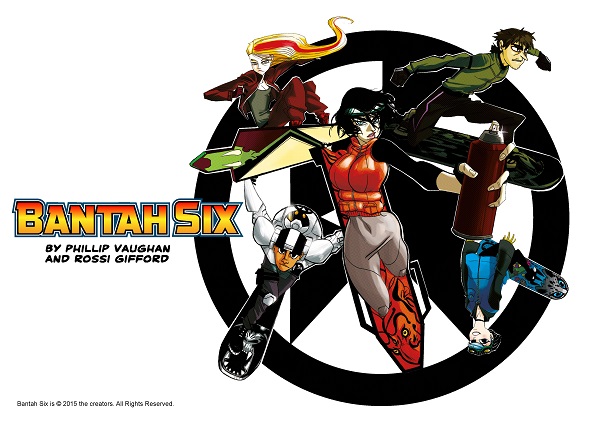
Volume 16 of David Lloyd’s weekly e-comic Aces Weekly beginning this week features the first publication of Bantah Six, a new strip from writer Phillip Vaughan and artist Rossi Gifford which tells the story of a graffiti gang on the city of New Terra.
Phillip Vaughan is a familiar face from the University of Dundee’s comics events as he is the Course Director for Duncan of Jordanstone College of Art and Design’s (DJCAD) MSc Animation and VFX programme and the creator and Module Leader of the Comic Art & Graphic Novels Expansive Module. As a 3D Animator and FMV Cutscene Producer he has worked on franchises as diverse as Farscape, Teletubbies, Wallace and Gromit and Star Trek.
Rossi Gifford is an alumnus of DJCAD who has had her work published in the university’s UniVerse publications Anthology and Tales From The Universe as well as publishing her own title Spirit Leaves. She is currently working as a freelance artist and concept designer in Toronto.
downthetubes’ Jeremy Briggs spoke to both creators about how the strip came about.
downthetubes: What are your comics backgrounds, how do you know each other, and how did your collaboration on Bantah Six come about?
Phillip Vaughan: I started off reading comics the traditional Scottish way, my mum and dad bought me the Beano and the Dandy! I then ‘graduated’ onto the new Eagle in 1982 (boys photo-stories!) where I was heavily influenced by the great painted artwork of Ian Kennedy (a fellow Dundonian, who I now have the pleasure of knowing!) on ‘Dan Dare’. From there I went on to collect 2000AD, which I have been getting regularly since 1984… I also picked up the occasional US import that happened to appear in the local newsagents, such as The Uncanny X-Men, The Incredible Hulk, The Amazing Spider-Man, Batman and Superman.
I met Rossi on the Comics Art and Graphic Novels Module that I run at Duncan of Jordanstone College of Art & Design in Dundee. She really excelled on the course, and has now moved to Canada to work in comics and animation. Just after Rossi graduated last May, I approached her with the idea of illustrating Bantah Six. I felt that her art style, and her work ethic, was a perfect match! I am glad she agreed!
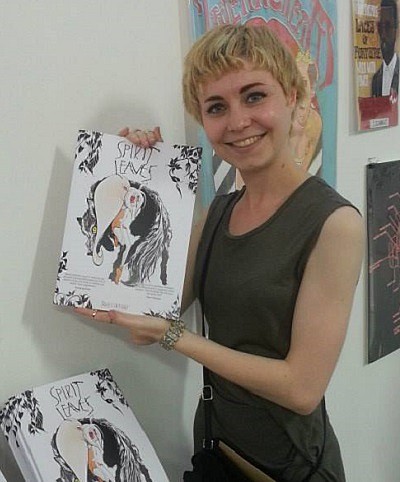
Rossi Gifford: When I was young I struggled in processing information. My senses took time to develop and sometimes it was frustrating to talk to other people and kids my age. One of my main morals to my creativity is that I want everyone to understand my visual stories.
I looked at comics at a pretty young age. I was fascinated with French comics, my family used to go to France every year and I would always collect some issues even if I couldn’t actually read it! Manga was very popular too and I bought some titles there that I could not get in the UK. I was never a “hard-core” collector but I did have some issues I always refered to for inspiration. Manga and anime then arrived properly in my teens and that triggered a huge influence in my drawing. I looked into Japanese woodblock printing too, I love the decorative landscapes. Frank Quietly, André Franquin, Osamu Tezuka, and Hayao Miyazaki’s Ghibli Films introduced me to strong characters, beautiful artwork and unique storytelling.
I did the General Foundation Course (at Dundee) and worked extremely hard to get into Illustration. I got in and during that time it was quite difficult. I was going through a process of figuring out what I could do – common art student thoughts. During my third year of university I saw the Comics Art and Graphic Novels Module and it was my first choice. I didn’t think about “will it make me a career?” but just knew it was for me and I’m so glad I did it.
Phil has been always positive about my work and continues to support me. Phil proposed Bantah Six to me to be the artist and I was so flattered. I love the story and the characters!
I then went to Canada to do some internships in Animation and Comics and loved it. I got my work permit and now live there! I believe hard work pays off! I aim to be known as “A Great Comic Artist”, haha!
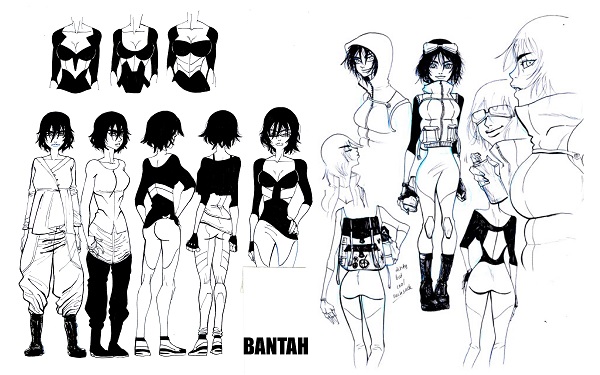
DTT: Where did the idea of Bantah Six come from and what is the basic premise of the strip?
Phil: I actually had the original idea when I was at art college back in 1995(!). I did my dissertation on Japanese Anime, and I took some inspiration from Akira and Ghost in the Shell. I developed the characters for an interactive display called ‘Cell’ which formed part of my degree show in 1996. Once I left art college I continued to develop the concept and in 1998 it was part of a business plan I had developed to produce original IP across different formats such as comics, TV, film and games.
The concept is that New Terra has constructed huge wave walls to protect the city from flooding. These walls are patrolled by ‘The Moderators’ who maintain law and order in the city. This has given rise to graffiti gangs, who roam the walls on their hover-boards, and who create their ‘art’ under the cover of darkness. Bantah Six is one such gang. They stumble across a rather dark conspiracy…
Rossi: When I first read the script for Bantah Six I instantly thought of Ghost in the Shell, Akira and Tekkokinreet. The first two titles I mentioned were some of the first “grown up” anime films I saw. I thought they were so cool and stylish.

DTT: With Phil being a digital artist and Rossi having written her own series, how did the division of labour on Bantah Six come about and was the strip more collaborative because you each knew the other’s job?
Phil: I had developed the characters visually years ago, principally to work in a 3D animation, however I really wanted to hand over the concept design to Rossi. I never showed Rossi the original designs, but I did give her detailed written descriptions, which she really went to town with! I am a firm believer in giving an artist plenty of room to manoeuvre! The collaboration works like so – I write a full script, Rossi sends me detailed thumbnails and roughs, and once approved she pencils and inks traditionally. The work is coloured digitally, then I letter the final art, changing some of the dialogue to fit. It seems to work quite well!
Rossi: I think Phil is great to work with! I have worked with others before where they are too picky or too brief… but Phil has always given enough information to work with but a lot of freedom for me to go a bit crazy on the designs. I love drawing fashion and like to dress the characters in their own trend. I always negotiate and explain about some feature I add to the characters etc. I always want clients to be satisfied with the overall look and like to keep them updated on the work process. As Phil said we collaborate so well!
I always aim to get a page done a day – I rough out the layouts then Blue Pencil the page and ink, this is done traditionally on paper, brush pens and markers. Photoshop allows me to clean up the page, make final adjustments and then colour. Applying flats always take the longest but seeing the page progress is great and after I send it to Phil who adds the text and sends it back for me to see is the best!

DTT: How did Bantah Six’s publication in Aces Weekly come about?
Phil: Last year I met up with David Lloyd at San Diego Comic Con, and I gave him a copy of Rossi’s self-published Spirit Leaves graphic novel (the second book is out later this year, check it out!), which he liked. We got chatting, and I mentioned that it would be great if we could showcase some up and coming talent from the courses in Dundee through Aces. He agreed in principle, so then I produced a production ‘bible’ for Bantah Six with Rossi in January with concept art and the first 2 episodes. Again, he liked what he saw, and that was it, it was in!
Rossi: Phil pretty much got his game face and just told me what David Lloyd was looking for (super chuffed that he is a fan of Spirit Leaves!). I cracked on with it and wanted to really draw some good stuff to show. This series has pushed me to try new techniques and get better at my draughtsmanship. I get great advice from the artists in the RAID Studio (in Toronto) on how to approach my work.
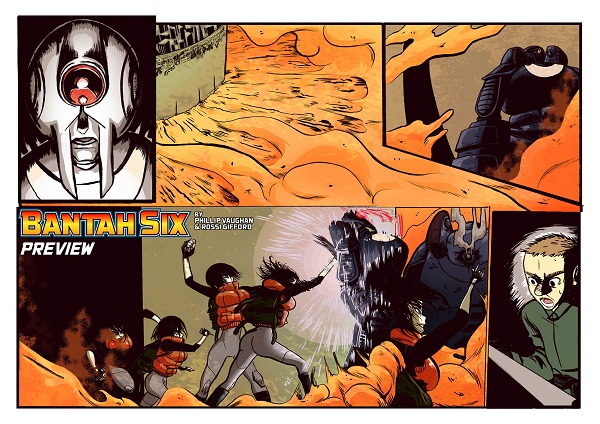
DTT: Did publication on-line change the initial formatting or layout of the strip or was it always intended for screens rather than print?
Phil: The formatting was vitally important. The structure of the landscape format is very different from a standard printed comics page. Luckily we planned this out in advance, so we didn’t have any serious resolution issues! This story was always created for on-screen viewing, however it could be re-proportioned to work in almost any format! That is the joy of the Aces format in a way, it’s adaptable!
Rossi: It is a different format to work in – there was one episode I drew that was done in portrait and I had to deconstruct it and put it all together in the horizontal layout. It was a good challenge and the page came out looking better. I like experimenting interesting ways to make a page flow (Spirit Leaves doesn’t have any formal structure and not restricted by borders) I like that I have had a chance to work in both layouts for print and digital comic publication. You must always make the story work and think how it is going to be read by the audience.
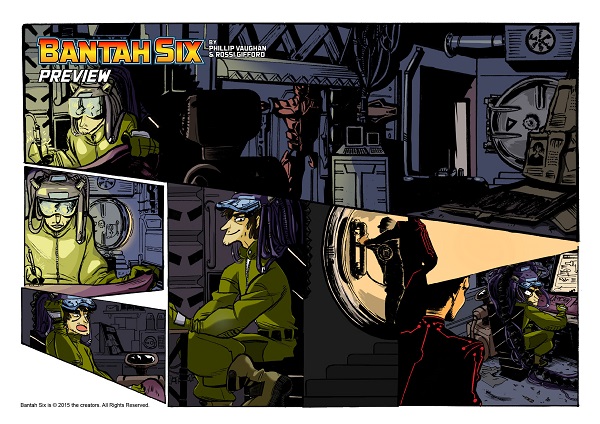
DTT: Would you envisage Bantah Six going to print at some point in the future or will it always remain as an e-comic?
Phil: Never say never! I think we will always concentrate on digital first versions, but possibly, down the line, a print version may be an option. I quite like black and white manga collections, so possibly a trade of the stories, toned and in black and white, once we have built up enough content! I would like to keep the story going in Aces Weekly, in a future volume, as we have plans to explore the team’s origins in the follow-up ‘book’.
Rossi: It is really up to Phil, we have spoken about it and it could look great printed! It is cheaper to have it available online and you can have a worldwide audience, so no limitations on how many you release. But I do like to collect my hardback books and really love the idea of the black and white manga collections for later issues. These will be fascinating as the work process will shift a little and you will learn more about the characters.
DTT: Phil and Rossi, thanks for taking the time to talk to us.
Bantah Six débuts in Volume 16 of Aces Weekly which is available via the Aces Weekly website.
There are more details of Phillip Vaughan’s work on his website.
Phillip was previously interviewed about his Dundee University/DJCAD work on downthetubes and appeared as a guest on the Scottish comics art blog Scotch Corner.
There are more details of Rossi Gifford’s work on her website which also includes details of her Spirit Leaves graphic novel.
There are more details of the comics courses at the University of Dundee and Duncan of Jordanstone College of Art and Design at the Scottish Comics Studies website which also has details of the titles published by UniVerse.
There are more details of Aces Weekly, as well as all the previous volumes of the title, at the Aces Weekly website.
News, reviews, interviews and features for print and on-line: Spaceship Away (since October 2005), Bear Alley (since February 2007), downthetubes (since June 2007), and Eagle Times (since October 2008). Plus DC Thomson’s The Art Of Ian Kennedy, Titan’s Dan Dare and Johnny Red reprints, Ilex’s War Comics: A Graphic History and 500 Essential Graphic Novels, and Print Media’s The Iron Moon and Strip magazine.
Categories: British Comics, Comic Creator Interviews, Creating Comics, Featured News, Features
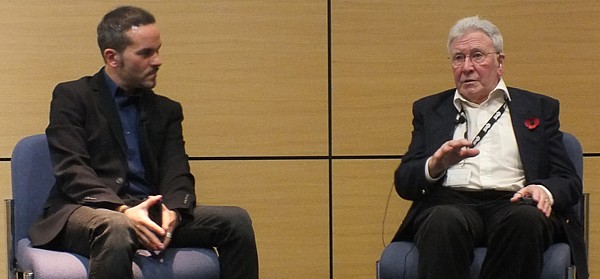
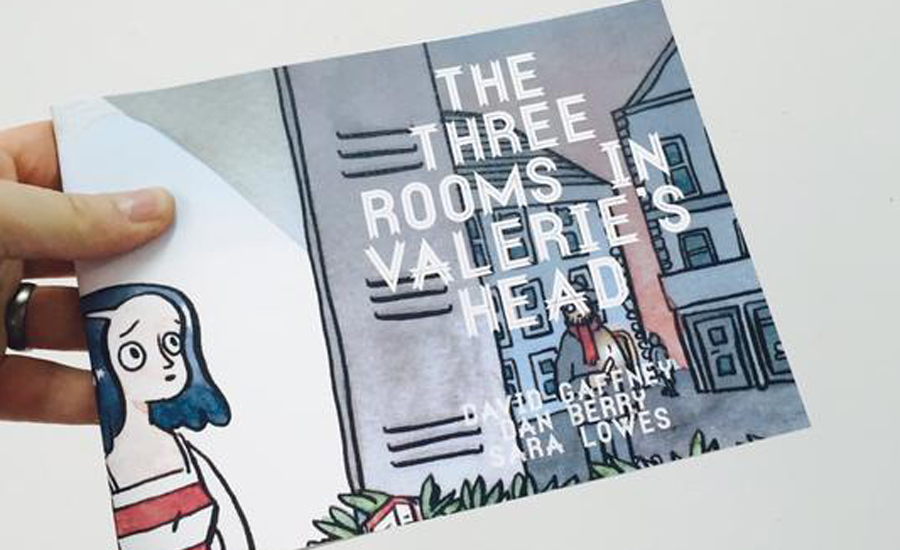 Lakes Festival Focus 2015: An Interview with Comic Creator and Educator, Dan Berry
Lakes Festival Focus 2015: An Interview with Comic Creator and Educator, Dan Berry 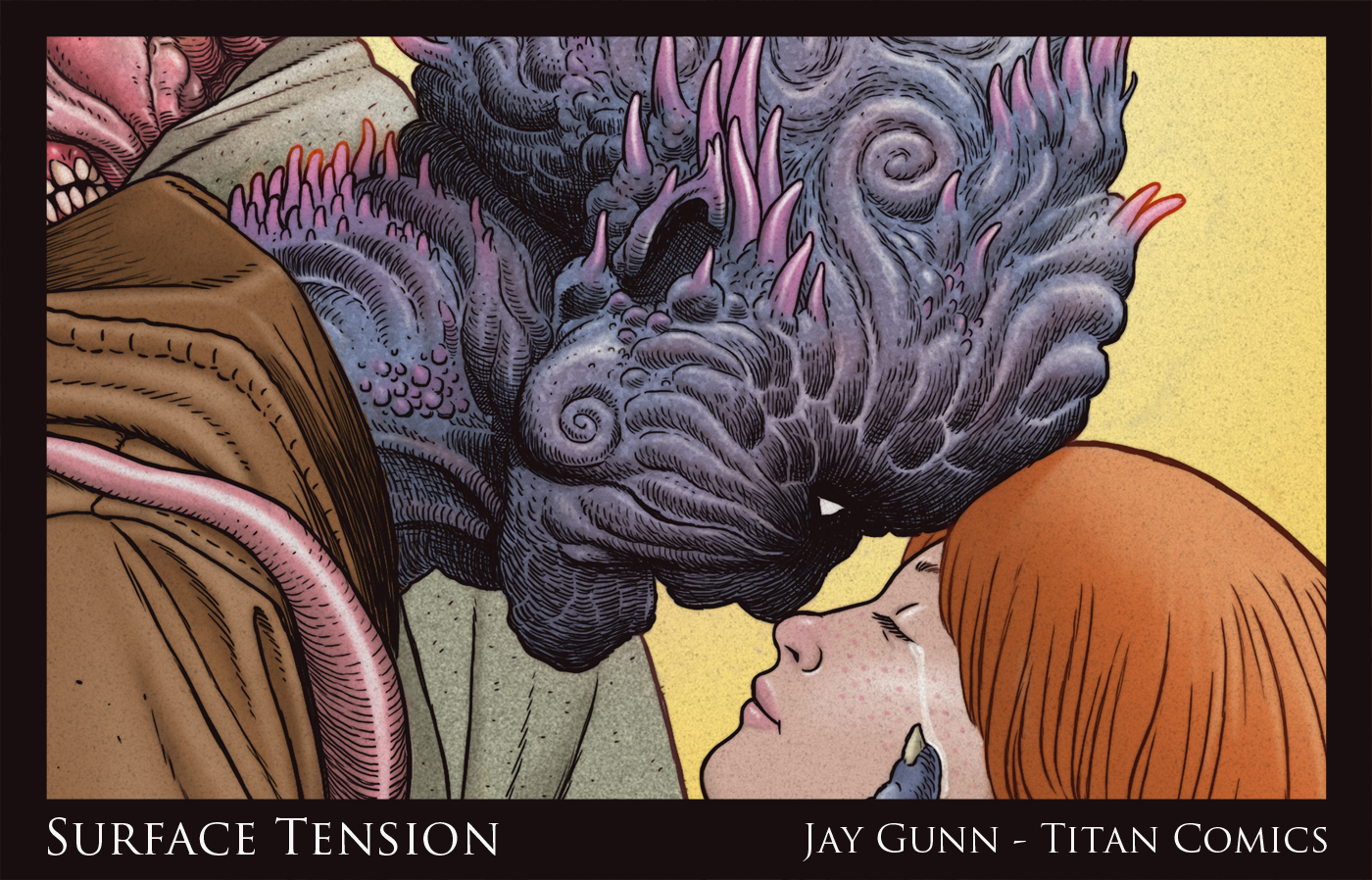 Breaking Surface: An Interview with Jay Gunn, creator of “Surface Tension”
Breaking Surface: An Interview with Jay Gunn, creator of “Surface Tension”  The Bear Facts: An Interview with Torsobear creator Brett Uren
The Bear Facts: An Interview with Torsobear creator Brett Uren  Propelled to Create: An Interview with Comics Writer Ricardo Mo
Propelled to Create: An Interview with Comics Writer Ricardo Mo